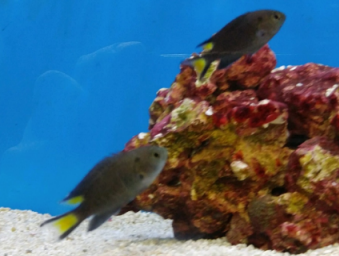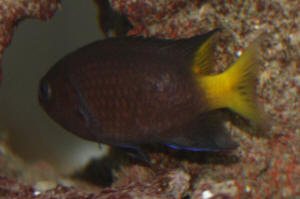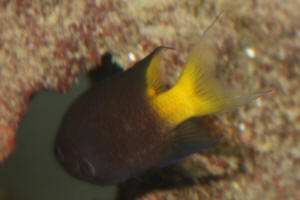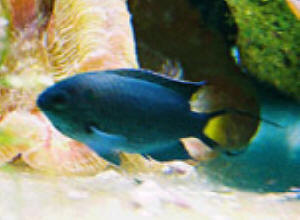|
Damselfish Identification - Neopomacentrus; & BR use
11/20/19
Good evening,
<Hi Joel>
I was at a local fish store today and came across these two lovely looking
Damselfish in the store's batch of "Assorted Damsels". I've only been
keeping saltwater fish for a short period of time, but have sufficient
experience in brackish fishkeeping to tentatively identify them as
Freshwater Demoiselles (Neopomacentrus taeniurus). I've never seen them
before in person and pictures online of the related N. cyanomos sometimes
appear similar, so I was hoping you might be able to verify for me.
<These appear to be Neopomacentrus taeniurus>
Sadly, I don't think they are appropriate for either of my tanks. My 125
gallon brackish tank at 1.006 may be too "fresh" and may squabble with the 8
Orange Chromides in it. On the other hand, I'd worry that it would fight
with my Talbot's Damsel in my 55 gallon saltwater.
In either case, just seeing this rare (to me) Damsel was enough of a treat.
Thank you for your time.
Joel
<Am going to ask Neale Monks here to respond re Pomacentrids for brackish
systems. His background w/ such systems is extensive. Bob Fenner>
Re: Damselfish Identification - Neopomacentrus /Neale
11/20/19
Hello Bob, Joel,
<Neale>
Yep, agree with the identification of your damselfish as Neopomacentrus
taeniurus, but with the cautious that there are other species, such as
Stegastes otophorus, that do look quite similar (especially the yellow
tail). That said, Neopomacentrus taeniurus does have a more deeply-forked
tail, suggesting your initial identification may well be correct.
I’ve seen Neopomacentrus taeniurus kept in freshwater tanks where they had
been in situ for at least six months, seemingly without harm. Companions
including Corydoras catfish and Angelfish of all things, and while the water
was certainly hard, it wasn’t salted. I suspect 1.006 will probably be
tolerated perfectly well, as these are truly euryhaline fish rather than
marine fish that happen to handle brackish water for longer or shorter
periods (as would be the case with, for example, Sergeant Majors). In some
places (including various oceanic Pacific islands) they inhabit completely
freshwater habitats alongside classic peripheral freshwater fish types like
Gobies that, in common with Neopomacentrus, have a marine reproductive stage
but as adults inhabit freshwater environments. I believe Neopomacentrus
taeniurus breed in the sea, however, rather than spawning in freshwater and
leaving their eggs to drift into the sea. Hence finding Neopomacentrus
taeniurus in freshwater, brackish, and fully marine habitats.
<Ahh>
My understanding is that they’re often found in harbours, estuaries, and
tidally-influenced rivers and streams, often quite murky ones (hence their
drab colouration). Water depth is rarely very great (less than 3m by one
source). Allen refers to them as dwellers of ‘inshore reefs’ so I guess your
classic coastal rocky reefs with oysters and mangroves rather than offshore
coral reefs seem to be their preferred habitat. My guess would be that
they’re much like various Apogon and Gobiidae species that are found in such
places: perfectly well adapted to varying salinity, able to handle low
salinity, even freshwater, for extended periods, but probably happiest (in
the sense of being able to spawn successfully) when kept in mid to high end
brackish conditions or fully marine salinities.
They are planktivores by nature, but consume all the usual foods that you’d
give small Damselfish.
I agree, Orange Chromides would likely be viewed as a competitor. There’s no
particular reason you couldn’t accommodate both given sufficient hiding
places, but you’d certainly want to plan ahead. I don’t know enough about
Neopomacentrus generally to comment on their social behaviour towards other
Damsels in a marine aquarium, but would imagine Neopomacentrus taeniurus are
par for the genus. Possibly Bob can add more here.
<The genus is more toward the easygoing spectrum of damsel territoriality;
not quite Chromis. I do consider, as you've stated re habitat, that they
should co-exist w/ Chromides.>
That pretty much covers what I know! The problem is they’re hardly ever
imported, and almost never kept in freshwater or brackish systems. I’m not
aware of any long term records beyond what I’ve reported above!
I’d be tempted to try them out with the Orange Chromides, and as/when they
mature, if they start looking seedy, or else behave abominably, then move
them into a more rough and tumble FOWLR system.
Cheers, Neale
<Thank you, BobF>
|
 |
|
Damsel color change? No image I bought a tank
from a guy who was getting out of the hobby... it was a 50 gallon
tank with 1 6" Jeweled damsel, <A bruiser here for
sure> two Clarkiis (3" and 3.5"), 1 cleaner wrasse
(dimidiatus), 1 coral beauty (1.5"), 1 Bristletooth Tang
(4"), 1 scopas tang (3.5"), and one 2" unknown
damsel. I've quarantined the cleaner, coral beauty, and
scopas to move to my 150 gallon (currently 2 ocellaris, 1 canary
wrasse... note the lack of the "Coris" misnomer :)...
<Ok... though I doubt this Halichoeres minds... I
don't> 1 2.5" starry eyed blenny, and two blue neon
gobies. Unfortunately, the Bristletooth didn't make it:( My
question concerns the "unknown" damsel. He's a dark
indigo (almost a dull black) except for his yellow tail that
extends beyond the tail to encompass the back fringe of the
dorsal and ventral fins. He also has blue edging on some fins.
<Photo please... or maybe a trip by you to a large library
(likely college with Bio./Zoo. dept., for a look/see at Gerald
Allen's works... oh, or a perusal through the Pomacentrid
family pix on Fishbase.org...
http://fishbase.org/identification/specieslist.cfm?famcode=350&areacode=>
Do the traditional blue yellowtailed damsel have a darker adult
stage like the jeweled damsel? <Traditional? Mmmm, no> Any
idea what this might be? Thanks for all you guys do!! Scott
<Take a look-see at the linked file... and/or send a pic or
two please. Bob Fenner> <Oh, I do see the pix included...
This does look like a Neopomacentrus species... maybe
Neopomacentrus violascens... search re... What do you think?
BobF. >
|

 |
|
Re: Damsel color change?
Neopomacentrus f', Lg. Angel sel.
2/22/09 Looks like you nailed it!! Thanks! Any different
behavior for this species? <Different? This is one of the
genera of Damsels that are neither totally solitary/territorial,
nor schooling-social... sort of mean, but not totally
stand-offish> The one I have is VERY shy and retiring... but I
think being overcrowded, including a couple bruisers (the 2
Clarkiis and the 6" jeweled damsel may not have given him
much choice. <Agreed> BTW the cleaner (who IS eating well
and looking very healthy... thank goodness), the coral beauty and
the scopas have successfully made the transition to my 150
gallon. Think they really appreciate the extra room. Unrelated
question, in the 150, besides the scopas, false Percs (2), canary
wrasse, starry eyed blenny, coral beauty, and cleaner wrasse, was
thinking of adding (over time) a threadfin butterfly, a Naso, and
a large angel. Initially was looking into King/Passer, but after
further consideration and reading, think maybe too
large/aggressive for a 150gallon. Any suggestions for a smaller
(reasonably priced:) large angel? <Mmm, my best choice here...
A Koran, P. semicirculatus. Bob Fenner>
|
|
Neopomacentrus azysron? (damsel id) Hello
folks-<Hi Steve, MacL here> I hope you have patience for
one more Damsel ID query-<Always and this was an interesting
one for me.> Does this resemble Neopomacentrus azysron? <It
does very closely resemble it. However, and azysron is
characterized by a solid yellow tail. Sadly i had to
rule that out since yours has the blue or black lines on the
tail.> Happy to say it's been very happy in my tank for
more than two years- frustrated that I can't quite nail the
id after many web searches. <I must say I have gone around and
around with it myself. Some of the other crew feels it is a
Neopomacentrus cyanomos (The "Regal
Demoiselle"). I see similarities with the
Crescent or regal damsel but if it is its not from the
indo-pacific but instead from another area and might possibly be
a color morph. Indonesian fish metallic green to black with a
distinctive white spot at end on dorsal fin base. That's not
your fish at all. However there are a couple of
pictures that are similar to it when you click on the fishbase
picture.> It displays what appears to be non-hostile
(flirtatious?) fin-splaying behavior around my GSM female; even
huddles with my GSM pair when frightened. About 3", not
counting the long streamers on the end of its tail- just a bit of
yellow on the inner part of the tail and bottom fin- not as much
as appears on fishbase specimen photos- any ideas?
thanks very much! <Personally I think it might be a cross of
some kind. But that's just my
opinion. Take a look at the regal or crescent damsel
in www.fishbase.org and see what you think. MacL>
|
|

|
|
|

